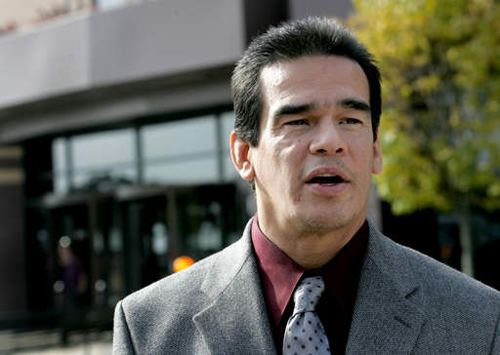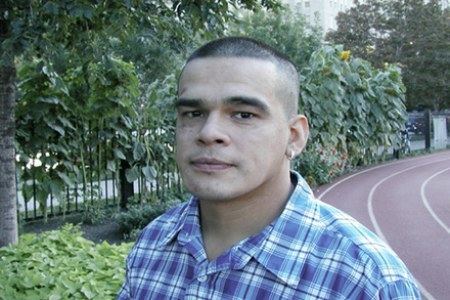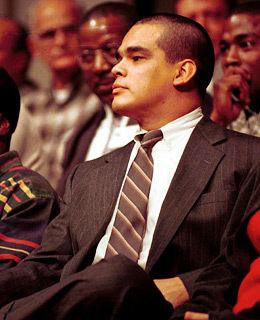 | ||
In February 1985, a Hispanic man from Aurora, Illinois named Rolando Cruz and a co-defendant were tried, wrongfully convicted, and sentenced to death for the 1983 kidnapping, rape, deviant sexual assault and murder of 10-year-old Jeanine Nicarico in DuPage County Circuit Court despite the fact that the police had no physical evidence linking them to the crime. Cruz was pardoned after more than 12 years in custody.
Contents

Events

On February 25, 1983, 10-year-old Jeanine Nicarico (born July 7, 1972) was abducted in broad daylight from her home in Naperville, Illinois. Suffering from the flu, Jeanine was at home alone while her parents were at work and her sisters were at school. Her body was found 2 days later, six miles from her home. She had been raped and beaten to death.

Rolando Cruz, a 20-year-old gang member from Aurora, was not initially a person of interest for the crime until he attempted to claim the $10,000 reward for information on the murder with a fabricated story. Several weeks later, Alejandro Hernandez, a high school dropout from Aurora came forward and said that three people had murdered Jeanine and that he knew two of them, Steven Buckley and "Ricky". Ricky was never found but Buckley's shoes were taken to compare with a print found at the scene and John Gorajczyk, a shoe print examiner in the police crime lab, concluded they didn't match. Gorajczyk later testified that lead prosecutor Thomas Knight told him to "keep his mouth shut" about the Buckley print not matching. Knight then sent the print and boots to the Illinois State Police crime lab who could not find a match so he then sent the boots and prints to an expert in Kansas who also found no match. Finally the print and boots were given to "shoe expert" Louise Robbins, who not only said Buckley's boots matched the print, but that she could tell the height and race of the wearer. Cruz, Hernandez and Buckley were indicted on 8 March 1984. After Robbins was discredited in 1986, the FBI crime lab conducted its own tests and concluded that Buckley's boot did not match the print.
There was enormous public and political pressure on the state attorney's office to solve the highly publicized case and the police and prosecutors became convinced of Cruz's guilt. One of the investigating detectives however was convinced of Cruz's innocence and resigned so he could testify for the defense. Later an Assistant Attorney General, Mary Brigid Kenney, also resigned claiming "I was being asked to help execute an innocent man". In 1987 Cruz, along with Alejandro Hernandez and Stephen Buckley, were charged with Jeanine's rape and murder despite a lack of evidence. At trial, two detectives testified that during an interview on May 9, 1983, Cruz had told them that he had had a vision about the Nicarico murder. He allegedly told them that Jeanine's nose had been broken, that she had been hit in the head so hard that a depression was left in the ground where her body was found, that she had been sodomized and that she had been left in a farmer's field, all details that had not been made public. Cruz maintained he had never made the statement, there was no police record of it and it had not been mentioned during the indictment trial three years earlier. Cruz and Hernandez were convicted in a joint trial and sentenced to death. The jury deadlocked on Buckley and he was not retried. The charges against Buckley were dropped on 5 March 1987.
In November 1985, another man, Brian Dugan, was sentenced to two consecutive life terms without parole for two unrelated similar homicides (one a seven-year-old girl) committed in nearby Kane and LaSalle Counties. At the time of his arrest he had also confessed to the Jeanine Nicarico murder but this information was withheld by prosecutors from Cruz's trial.
First Appeal
The convictions were overturned on January 19, 1989 due to a prosecutorial error and Cruz and Hernandez were retried separately. Dugan's confession had now been accepted although his claim that he did it alone was rejected. The prosecution now maintained that Dugan, Cruz and Hernandez jointly committed the murder and that Cruz was the rapist. As it had in the original trial, the prosecution case had rested in part on the likelihood that two shoeprints below a window of the Nicarico home belonged to Hernandez or Cruz. A crime lab technician for the DuPage County Sheriff's office, Paul Sahs, was due to testify to this at the retrial. According to Sahs' testimony before the later DuPage 7 grand jury he had asked the prosecutors to be excused as Nike officials had told him that the prints were made by a woman's shoe, size 5 1/2 or 6, too small for either Hernandez or Cruz. The prosecutors declined to pass this information to the defense as required by law and went on to put Sahs on the stand without asking him about shoe size or the sex of the wearer.
The Illinois Supreme Court upheld Cruz' conviction and death sentence in February, 1990. Justice Heiple, writing for the majority, found errors in the trial but dismissed them as harmless in light of the "overwhelming" physical evidence. This decision sparked an understandable public outcry, since even prosecutors had to admit that no physical evidence existed linking Cruz to the crime, much less "overwhelming" physical evidence. Hernandez' second trial ended in a hung jury, but a third trial ended in his conviction. On May 17, 1991, Hernandez was sentenced to 80 years in prison.
Further appeals and exoneration
Cruz appealed again in December, 1992 and his second conviction was again upheld by the Illinois Supreme Court. Assistant Attorney General Mary Brigid Kenney, who was assigned to fight Cruz's appeal, sent a memo to Illinois Attorney General Roland Burris identifying numerous errors in the investigation and trial in Cruz's initial conviction including "perjured testimony" and "fraudulent investigations by local officials". Burris disputed Kenney's contentions, claiming he could not hold his judgement higher than the jury and that it was his job to uphold a jury's decision and Kenney resigned in protest.
In 1994 the verdict was overturned again. During the third trial, a sheriff's lieutenant who had testified regarding Cruz's "vision" at the original trial reversed his testimony and admitted he had lied under oath and that Cruz had not made the statement, DNA tests also eliminated Cruz and his co-defendant, Alejandro Hernandez as the contributors of the semen found at the crime scene and implicated Brian Dugan who had confessed to the crime in 1985. On November 3, 1995, a DuPage County judge acquitted Cruz on the basis of recanted testimony, the DNA evidence, and the lack of any substantiated evidence against Cruz. In December 1995, the charges against Hernandez were dismissed by the State's Attorney.
Aftermath
Seven DuPage County law enforcement officials, three prosecutors and four deputies, were indicted by a grand jury in December 1996 on 47 charges of conspiracy to convict Cruz despite being aware of exculpatory evidence. The indictment rested on two main points, that two detectives had testified that Cruz had told them that he had had a "vision" of the murder that contained details known only to the killer, a lie that was never included in any police report which was "endorsed and perpetuated by the prosecutors" and that the prosecutors had concealed Brian Dugan's confession while knowing that it had included accurate details indicating he had committed the crime. In April 1999, the trial of the "DuPage Seven." began, and ultimately all seven officers were found not guilty by Judge William Kelly. However, a civil suit brought by Cruz, Hernandez and Buckley was settled by DuPage County for $3.5 million in autumn of 2000. According to the Chicago Tribune, that the case made it to trial was a legal benchmark. Since 1966 there had been 381 homicide convictions in the United States reversed on the grounds that prosecutors knowingly used false evidence or withheld evidence suggesting innocence. Of these, 46 were tried in Illinois which had the second highest total and twice as many as the state that ranked third. Only two of those cases resulted in indictments of prosecutors and both were dismissed before trial.
Cruz was fully pardoned by Governor George Ryan in 2002. A third man, Steven Buckley, who was also initially suspected of the crime, due to his alleged bootprint being found on the Nicario's front porch, was also cleared of any wrongdoing.
In November 2005, Dugan was indicted for the Nicarico murder. On July 28, 2009, 52-year-old Dugan pleaded guilty with his 1985 confession being made public for the first time on October 14. On October 7, 2009, the jury determined Dugan was eligible for the death penalty which under state law requires that he qualifies for at least one of four conditions: that the victim was younger than 12, the crime was exceptionally brutal and heinous, a previous conviction for at least one other murder or that the crime was committed during the course of another felony. The sentencing phase is expected to last up to six weeks.
The public outcry from the Cruz case resulted in Governor George Ryan declaring a moratorium on the death penalty in Illinois, asserting that the system was "fraught with error."
On March 11, 2011, Illinois Governor Pat Quinn signed legislation abolishing the death penalty in Illinois into law.
